Estimation of Changes in the Nutrient Release Rate from Sediments after a Tsunami by an Incubation Experiment
Abstract
1. Introduction
2. Materials and Methods
2.1. Study Site
2.2. Incubation Experiment
2.3. Calculation Methods
3. Results
3.1. Oxygen Consumption Rate
3.2. Release Rates
4. Discussion
4.1. Oxygen Consumption Rate
4Fe2+ + O2 + 6H2O → 4FeOOH + 8H+
H2S → SO42− + 2H+
4.2. Release Rates
4.3. Comparison with Previous Release Rates
5. Conclusions
Author Contributions
Funding
Data Availability Statement
Acknowledgments
Conflicts of Interest
References
- Hidaka, M.; Wakui, K.; Kamiyama, K.; Takasaki, T.; Nishi, R.; Yamashita, S.; Hayashi, K. Change in sediment characters and bathymetry in Matsukawaura Inlet due to the tsunami on March 11, 2011. J. Jpn. Soc. Civ. Eng. Ser. B3 (Ocean Eng.) 2021, 68, I_186–I_191. (In Japanese) [Google Scholar] [CrossRef]
- Seike, K.; Kobayashi, G.; Kogure, K. Post-depositional alteration of shallow-marine tsunami induced sand layers: A comparison of recent and ancient tsunami deposits, Onagawa Bay, northeastern Japan. Isl. Arc 2017, 26, e12174. [Google Scholar] [CrossRef]
- Kamiyama, T.; Yamauchi, H.; Nagai, S.; Yamaguchi, M. Differences in abundance and distribution of Alexandrium cysts in Sendai Bay, northern Japan, before and after the tsunami caused by the Great East Japan Earthquake. J. Oceanogr. 2014, 70, 185–195. [Google Scholar] [CrossRef]
- Natsuike, M.; Kanamori, M.; Baba, K.; Moribe, K.; Yamaguchi, A.; Imai, I. Changes in abundances of Alexandrium tamarense resting cysts after the tsunami caused by the Great East Japan Earthquake in Funka Bay, Hokkaido, Japan. Harmful Algae 2014, 39, 271–279. [Google Scholar] [CrossRef]
- Tsujimoto, R.; Terauchi, G.; Sasaki, H.; Sakamoto, S.X.; Sawayama, S.; Sasa, S.; Yagi, H.; Komatsu, T. Damage to seagrass and seaweed beds in Matsushima Bay, Japan, caused by the huge tsunami of the Great East Japan Earthquake on 11 March 2011. Int. J. Remote Sens. Remote Sens. Lett. 2016, 37, 5843–5863. [Google Scholar] [CrossRef]
- Komatsu, T.; Ohtaki, T.; Sakamoto, S.; Sawayama, S.; Hamana, Y.; Shibata, M.; Shibata, K.; Sasa, S. Impact of the 2011 Tsunami on seagrass and seaweed beds in Otsuchi Bay, Sanriku Coast, Japan. In Marine Productivity: Perturbations and Resilience of Socio-Ecosystems; Ceccaldi, H.J., Hénocque, Y., Koike, Y., Komatsu, T., Stora, G., Tusseau-Vuillemin, M.H., Eds.; Springer International Publishing: Cham, Switzerland, 2015; pp. 43–53. [Google Scholar] [CrossRef]
- Katayama, S.; Kaneto, Y. Effects of the huge tsunami in 2011 on coastal fisheries and coastal resources and their recovering states. Nippon Suisan Gakkaishi 2018, 84, 1083–1087. (In Japanese) [Google Scholar] [CrossRef]
- Kaneko, K.; Takahashi, D.; Gomi, T.; Syoji, M.; Abe, H.; Fujii, T.; Katayama, A.; Yamaguchi, T.; Kijima, A. Impact of the 2011 Tohoku Earthquake and tsunami on the state of seafloor sediment and benthic macrofauna and their recovery process in Onagawa Bay. Nippon Suisan Gakkaishi 2018, 84, 909–912. (In Japanese) [Google Scholar] [CrossRef]
- Okoshi, S.W. Impacts of earthquake and tsunami on macrobenthic community inhabiting soft bottom. Nippon Suisan Gakkaishi 2018, 84, 1062–1065. (In Japanese) [Google Scholar] [CrossRef]
- Headquarters for Earthquake Research Promotion, Government of Japan, Jishin Nitaisuru Hyoka, Chokihyoka, Chokihyokakekkaichiran (List of long-Term Evaluation Results for Earthquakes). Available online: https://www.jishin.go.jp/evaluation/long_term_evaluation/lte_summary/ (accessed on 21 January 2023). (In Japanese).
- Nakada, S.; Hayashi, M.; Koshimura, S.; Yoneda, S.; Kobayashi, E. Tsunami-tide simulation in a large bay based on the greatest earthquake scenario along the Nankai Trough. Int. J. Offshore Polar Eng. 2016, 26, 392–400. [Google Scholar] [CrossRef]
- Nakada, S.; Hayashi, M.; Koshimura, S. Transportation of sediment and heavy metals resuspended by a giant tsunami based on coupled three-dimensional tsunami, ocean, and particle-tracking simulations. J. Water Environ. Technol. 2018, 16, 161–174. [Google Scholar] [CrossRef]
- Kinki Regional Development Bureau, Ministry of Land, Infrastructure, Transport and Tourism, Government of Japan, Osaka Wan Kankyo Zusetsu (Osaka Bay Environmental diagrams), Kinki Regional Development Bureau, Ministry of Land, Infrastructure, Transport and Tourism, Government of Japan: Osaka, Japan. 2020. 141p. Available online: http://kouwan.pa.kkr.mlit.go.jp/kankyo-db/data/latest/zusetsu.aspx (accessed on 21 January 2023). (In Japanese).
- Tada, K.; Nakajima, M.; Yamaguchi, H.; Asahi, T.; Ichimi, K. The Nutrient Dynamics and bottom sediment in coastal water. Bull. Coast. Oceanogr. 2018, 55, 113–124. (In Japanese) [Google Scholar] [CrossRef]
- Yamamoto, T.; Matsuda, O.; Hashimoto, T.; Imose, H.; Kitamura, T. Estimation of benthic fluxes of dissolved inorganic nitrogen and phosphorus from sediments of the Seto Inland Sea. Umino Kenkyu 1998, 7, 151–158. (In Japanese) [Google Scholar] [CrossRef]
- Inoue, T.; Nakamura, Y. Effects of hydrodynamic conditions on sediment oxygen demand: Experimental study based on three methods. J. Environ. Eng. 2009, 135, 1161–1170. [Google Scholar] [CrossRef]
- Inoue, T.; Hagino, Y. Effects of three iron material treatments on hydrogen sulfide release from anoxic sediments. Water Sci. Technol. 2022, 85, 305–318. [Google Scholar] [CrossRef]
- Glud, R.N.; Gundersen, J.K.; Holby, O. Benthic in situ respiration in the upwelling area off central Chile. Mar. Ecol. Prog. Ser. 1999, 186, 9–18. [Google Scholar] [CrossRef]
- Inoue, T.; Sugahara, S.; Seike, Y.; Kamiya, H.; Nakamura, Y. Short-term variation in benthic phosphorus transfer due to discontinuous aeration/oxygenation operation. Limnology 2017, 18, 195–207. [Google Scholar] [CrossRef]
- Boudreau, B.P. Diagenetic Models and Their Implementation; Springer: Berlin/Heidelberg, Germany, 1996; pp. 37–47, 75–77, 96–117. [Google Scholar]
- Carreira, C.; Larsen, M.; Glud, R.N.; Brussaard, C.P.D.; Middelboe, M. Heterogeneous distribution of prokaryotes and viruses at the microscale in a tidal sediment. Aquat. Microb. Ecol. 2013, 69, 183–192. [Google Scholar] [CrossRef]
- Gundersen, J.K.; Jørgensen, B.B. Microstructure of diffusive boundary layers and the oxygen uptake of the sea floor. Nature 1990, 345, 604–607. [Google Scholar] [CrossRef]
- Hayashi, M.; Nakada, S.; Koshimura, S.; Kobayashi, E. Estimate of water quality change in Osaka Bay caused by the suspension of marine sediment with mega tsunami. In Oceanography Challenges to Future Earth; Komatsu, T., Ceccaldi, H.J., Yoshida, J., Prouzet, P., Hénocque, Y., Eds.; Springer Nature: Cham, Switzerland, 2019; pp. 45–54. [Google Scholar] [CrossRef]
- Inoue, T.; Nakamura, Y. Response of benthic soluble reactive phosphorus transfer rates to step changes in flow velocity. J. Soils Sediments 2012, 12, 1559–1567. [Google Scholar] [CrossRef]
- Kagawa, H.; Tokumasu, M. Effects of covering sea sediment upon the release of nutrients into seawater—indoor model experiment-. Jpn. J. Water Pollut. Res. 1983, 6, 319–326. (In Japanese) [Google Scholar] [CrossRef]
- Jyo, H. Studies on the Mechanism of Eutrophication and the Effect of It on Fisheries Production in Osaka Bay. Bull. Osaka Prefect. Fish. Exp. Stn. 1986, 7, 1–174. (In Japanese). Available online: https://www.knsk-osaka.jp/_files/00055802/7-index.pdf (accessed on 21 January 2023).
- Ministry of the Environment, Government of Japan. Osakawan Niokeru Teidei Karano Nijiodakubussitu no Shugenin Tonaru Eiyouennruiyoushutsuhaakujittaityosa (Investigation of the Nutrients Release from Bottom Sediments in Osaka Bay That Are the Main Cause of Secondary Pollutants); Tokyo Kuei: Tokyo, Japan, 2001; 71p. (In Japanese) [Google Scholar]
- Nishio, T.; Shinya, M. Effect on nutrient load of removing sediments by maintenance dredging in the Port of Osaka. Nippon Suisan Gakkaishi 2010, 76, 886–893. (In Japanese) [Google Scholar] [CrossRef]
- Nakajim, M.; Yamamoto, K.; Sano, M.; Ariyama, K. Engankaiiki no Eiyoenkannrigijyutu no Kaihatsuitakujigyo Seikahokokusyo (Report of Development of Nutrient Management Technology for Coastal Waters); The Japan Fisheries Research and Education Agency: Hiroshima, Japan, 2013; pp. 60–68. (In Japanese)
- Nakajim, M.; Yamamoto, K.; Sano, M.; Akiyama, S.; Ariyama, K. Engankaiiki no Eiyoenkannrigijyutu no Kaihatsuitakujigyo Seikahokokusyo (Report of Development of Nutrient Management Technology for Coastal Waters); The Japan Fisheries Research and Education Agency: Hiroshima, Japan, 2014; pp. 62–74. (In Japanese)
- Komai, Y. Teishitsu no Jyokyo to naibufuka (Sediment conditions and internal loads). J. Environ. Conserv. Eng. 2015, 44, 128–133. (In Japanese) [Google Scholar]
- Nishikawa, T.; Hori, Y.; Nagai, S.; Miyahara, K.; Nakamura, Y.; Harada, K.; Tanda, M.; Manabe, T.; Tada, K. Nutrient and Phytoplankton Dynamics in Harima-Nada, Eastern Seto Inland Sea, Japan During a 35-Year Period from 1973 to 2007. Estuaries Coasts 2010, 33, 417–427. [Google Scholar] [CrossRef]
- Abo, K.; Akiyama, S.; Harada, K.; Nakaji, Y.; Hayashi, H.; Murata, K.; Wanishi, A.; Ishikawa, Y.; Masui, T.; Nishikawa, S.; et al. Long-Term Variations in Water Quality and Causal Factors in the Seto Inland Sea, Japan. Bull. Coast. Oceanogr. 2018, 55, 101–111. (In Japanese) [Google Scholar] [CrossRef]
- Hori, Y.; Mochizuki, S.; Shimamoto, N. Relationship between the discoloration of cultivated Porphyra thalii and long-term changes of the environmental factors in the northern part of Harima-Nada, eastern Seto Inland Sea, Japan. Bull. Jpn. Soc. Fish. Oceanogr. 2018, 72, 107–112. (In Japanese). Available online: https://www.jsfo.jp/archives/contents/pdf/72-2-107.pdf (accessed on 21 January 2023).
- Tanida, M.; Akashige, S.; Ariyama, H.; Yamanoi, H.; Kimura, H.; Dan, A.; Sakamoto, H.; Saiki, Y.; Ishida, Y.; Kotobuki, H.; et al. Nutrient environment and fisheries in the Seto Inland Sea. J. Fish. Technol. 2014, 7, 37–46. (In Japanese). Available online: https://www.fra.affrc.go.jp/bulletin/fish_tech/7-1/070105.pdf (accessed on 21 January 2023).
- Yamamoto, T. The Seto Inland Sea—Eutrophic or oligotrophic? Mar. Pollut. Bull. 2003, 47, 37–42. [Google Scholar] [CrossRef]
- Fujiwara, T.; Suzuki, K.; Okubo, K. Impact of Nutrient Reduction on Organic Matter (COD and TOC) in Coastal Embayments: Effect of the Reduction and Its Working Mechanism. J. Jpn. Soc. Water Environ. 2021, 44, 185–193. (In Japanese) [Google Scholar] [CrossRef]
- Fujiwara, T.; Suzuki, K.; Kimura, N.; Suzuki, M.; Nakajima, M.; Tadokoro, K.; Abo, K. Impact of variation in nutrient concentration on ecosystem, biomass and production in a semi-enclosed embayment: Osaka Bay. J. Jpn. Soc. Water Environ. 2022, 45, 145–158. (In Japanese) [Google Scholar] [CrossRef]
- Abo, K.; Nakagawa, N.; Abe, K.; Tarutani, K. Tobusetonaikai niokeru eiyouen no dotai to noriyousyoku nadonotameno eiyouennkannri (Nutrient Dynamics and management in the Eastern Seto Inland Sea). Aquabiology 2015, 37, 274–279. (In Japanese) [Google Scholar]
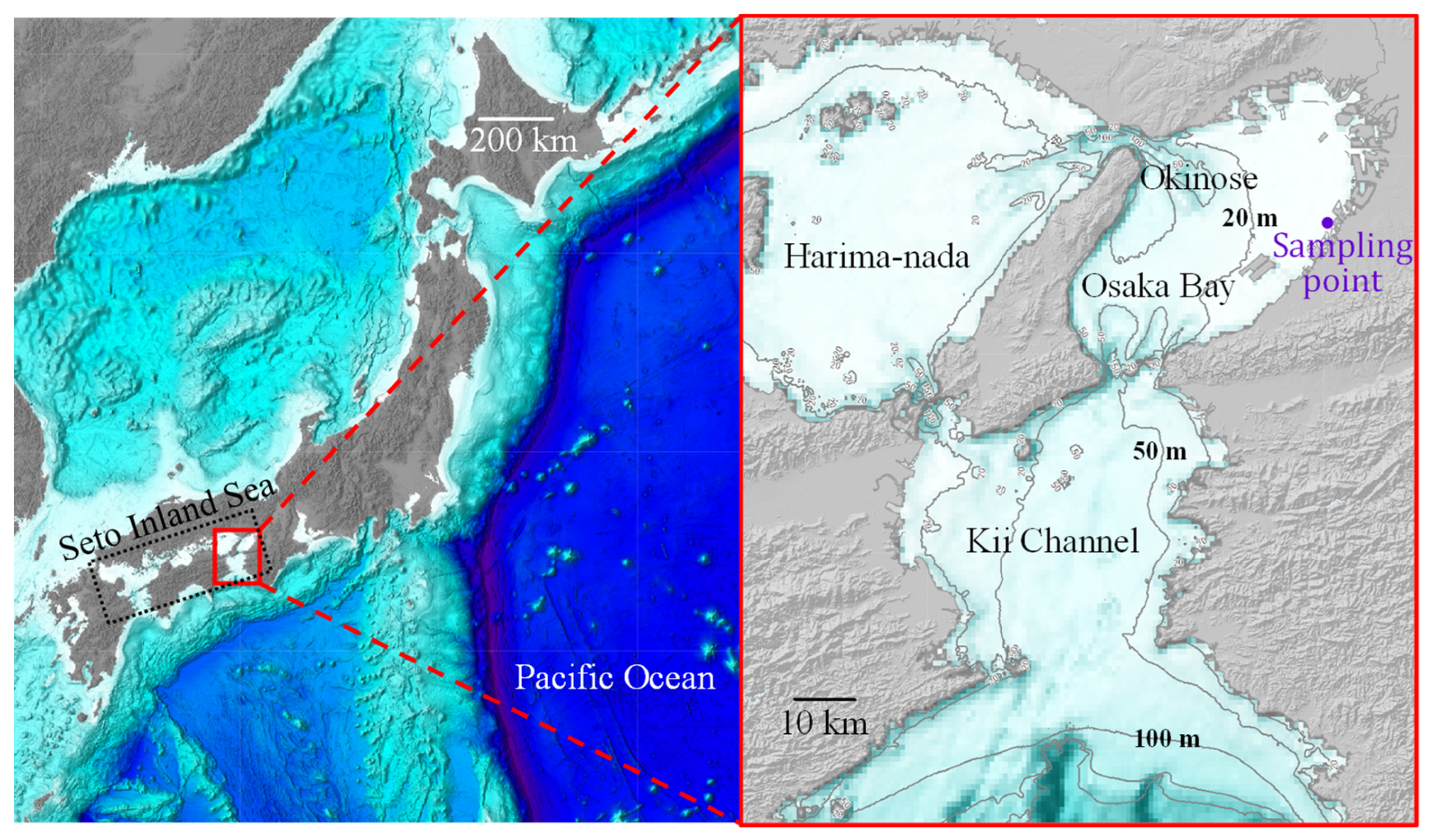
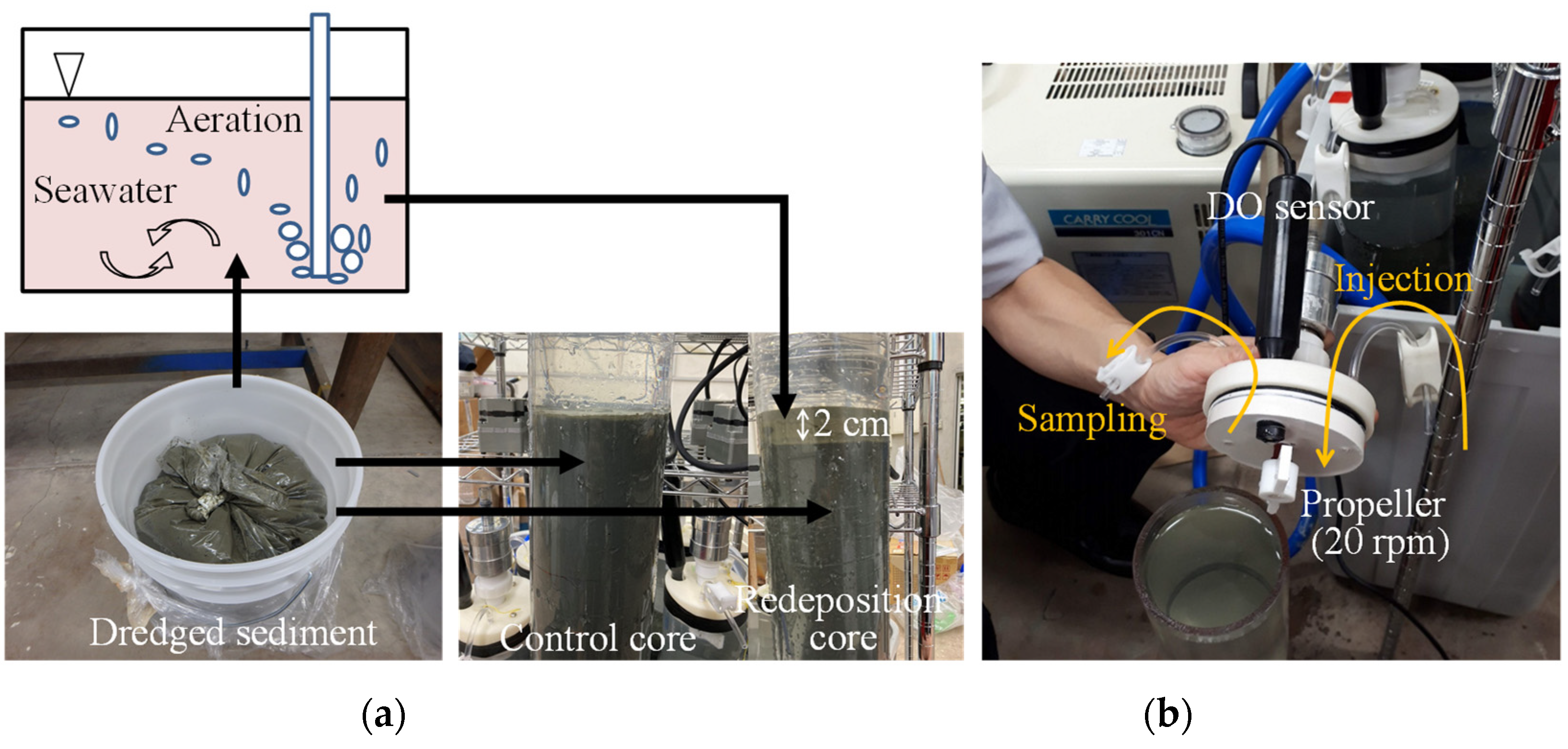
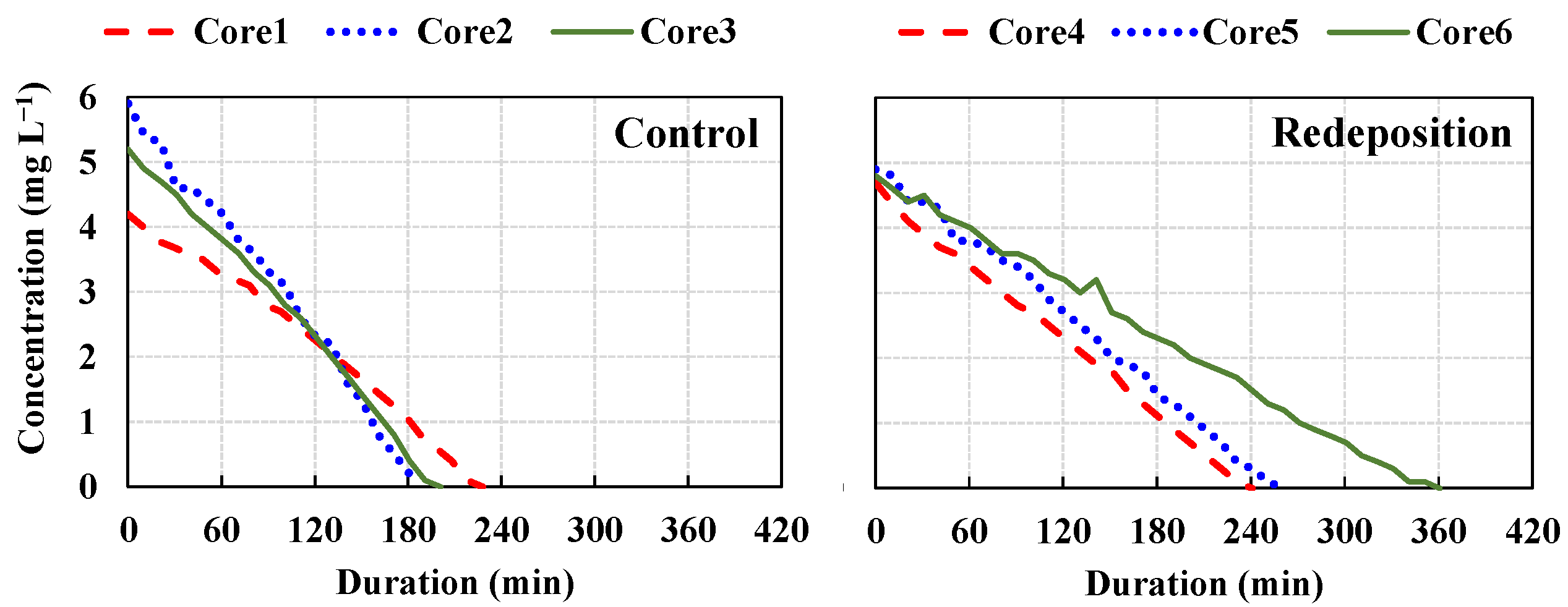




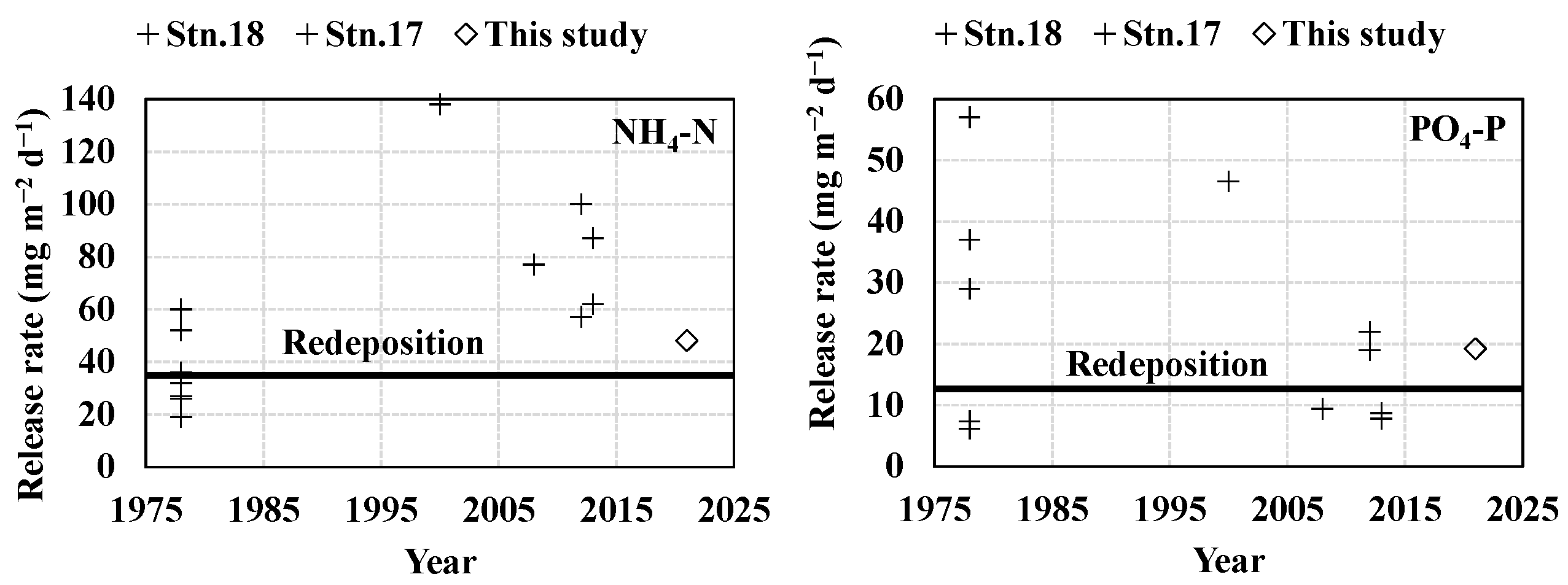
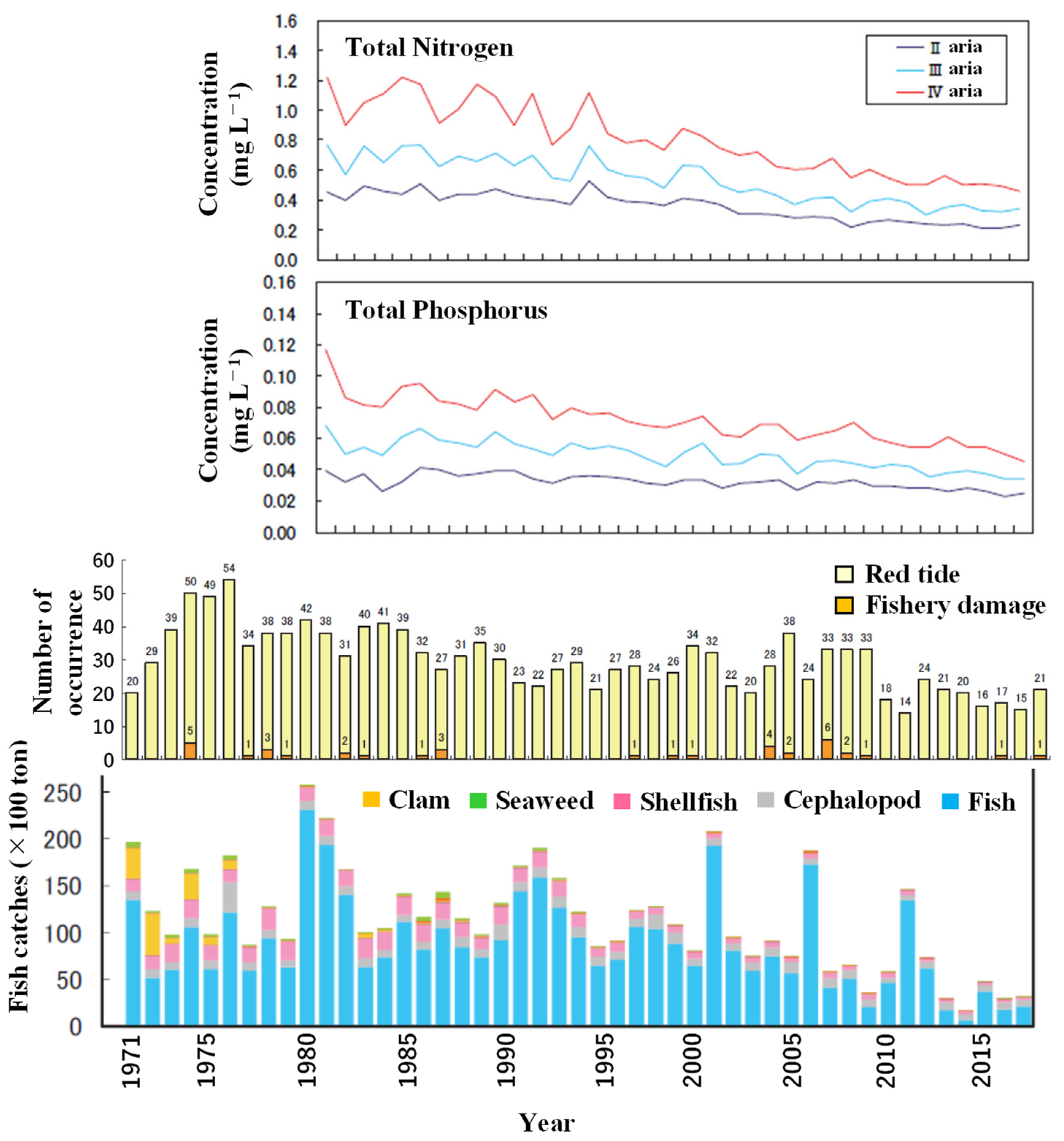
| References | Stations | Sampling Month & Year |
|---|---|---|
| Jyo [26] | Stn.18 & Stn.17 | June, July, August & October, 1978 |
| Yamamoto et al. [15] | M03 | October, 1993 & June, 1994 |
| Ministry of the Environment [27] | Unknown | August, 2000 |
| Nishio & Shinya [28] | P0 | September, 2008 |
| Nakajim et al. [29] | Stn.18 | July & October, 2012 |
| Nakajim et al. [30] | Stn.18 | July & October, 2013 |
Disclaimer/Publisher’s Note: The statements, opinions and data contained in all publications are solely those of the individual author(s) and contributor(s) and not of MDPI and/or the editor(s). MDPI and/or the editor(s) disclaim responsibility for any injury to people or property resulting from any ideas, methods, instructions or products referred to in the content. |
© 2023 by the authors. Licensee MDPI, Basel, Switzerland. This article is an open access article distributed under the terms and conditions of the Creative Commons Attribution (CC BY) license (https://creativecommons.org/licenses/by/4.0/).
Share and Cite
Hayashi, M.; Inoue, T.; Hirokawa, S. Estimation of Changes in the Nutrient Release Rate from Sediments after a Tsunami by an Incubation Experiment. Water 2023, 15, 2041. https://doi.org/10.3390/w15112041
Hayashi M, Inoue T, Hirokawa S. Estimation of Changes in the Nutrient Release Rate from Sediments after a Tsunami by an Incubation Experiment. Water. 2023; 15(11):2041. https://doi.org/10.3390/w15112041
Chicago/Turabian StyleHayashi, Mitsuru, Tetsunori Inoue, and Soichi Hirokawa. 2023. "Estimation of Changes in the Nutrient Release Rate from Sediments after a Tsunami by an Incubation Experiment" Water 15, no. 11: 2041. https://doi.org/10.3390/w15112041
APA StyleHayashi, M., Inoue, T., & Hirokawa, S. (2023). Estimation of Changes in the Nutrient Release Rate from Sediments after a Tsunami by an Incubation Experiment. Water, 15(11), 2041. https://doi.org/10.3390/w15112041







